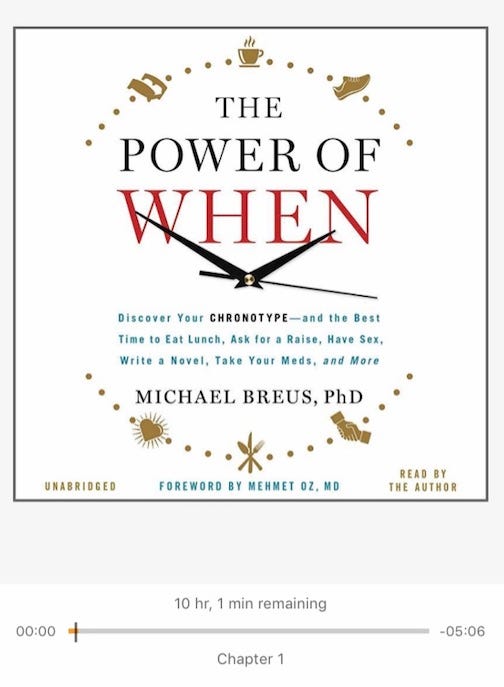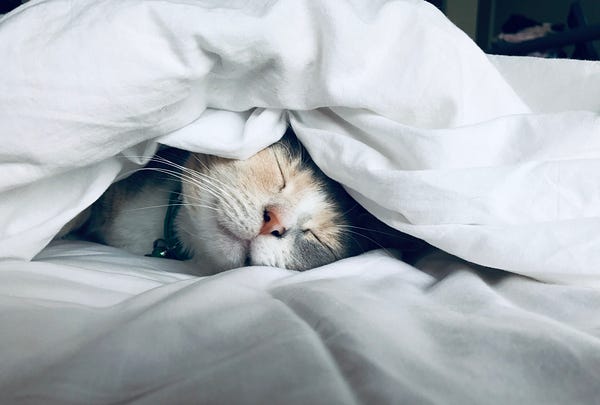The Power of When by Michael Breus

I read this book after reading When: The Scientifics of Perfect Timing by Daniel H. Pink and thought that it might be a good complement to it. While there were plenty of great takeaways from this book and definitely one of the most impactful that I have finished this year, it was structured differently than was Daniel Pink’s book. This was all about the way that each of us are structured as individuals. We are all very different people and operate based on a different chronotype — our internal biological clock. Chronotypes are also defined as behavioral manifestation of underlying circadian rhythms of myriad physical processes.
The first thing that I noted was the 4 different chronotypes that the author shared. To find out your chronotype, take the author’s online quiz here or maybe you’ll be able to determine it for yourself just by reading what I’ve written. I am a lion and ideally would sleep by 10:00 and wake by 5:30 each morning.
4 chronotype categories
1. Dolphins — insomniacs, intelligent neurotic light sleepers with low sleep drive
2. Lions — morning-oriented driven optimists with a medium sleep drive
3. Bears — fun, loving, outgoing people who enjoy a solar sleep schedule and have a high sleep drive
4. Wolves — night-oriented creative extroverts with a medium sleep drive
The author then went into a further breakdown of each of the 4 chronotypes — beginning with dolphins. I highlighted the 4 key personality traits and the 4 key behaviors along with a short explanation of some further characterizations for each chronotype which I will share below:
Dolphin’s 4 key personality traits
1. Cautiousness
2. Introversion
3. Neuroticism
4. Intelligence
Dolphin’s 4 key behaviors
1. Avoiding risky situations
2. Striving for perfection
3. Obsessive-compulsive tendencies
4. Fixating on details
Dolphins usually wake up feeling unrefreshed and are tired until late in the evening when they suddenly hit their stride. Most productive in random spurts.
Can cause anxiety-related insomnia based on their low sleep drive and light sleeping patterns.
Often get mired in details, can get lost in emotion. Are usually less guarded in relationships.
Next are the lion’s 4 key personality traits and key behaviors followed by a short explanation of some further characterizations. I highlighted a lot more of the description here as I related most directly to the lion chronotype and after taking the online quiz, determined that I am indeed a lion. Calculated risk, purposeful energy, and facing challenges head-on are all things that I do on purpose and consistently. Along with that, the 4 key personality traits and the 4 key behaviors are all things that I hold close to heart, each of those things are parts of my identity.
Lion’s 4 key personality traits
1. Conscientiousness
2. Stability
3. Practicality
4. Optimism
Lion’s 4 key behaviors
1. Overachieving
2. Prioritizing health and fitness
3. Seeking positive interactions
4. Strategizing
Wake up bright eyed and fall asleep easily, most alert at noon and most productive in the morning. Rarely nap, lions would rather be doing something useful.
Lions burst with purposeful energy, and a bright-eyed go get em eagerness. Face challenges head on with clear objectives and a strategy to success. It’s about getting from point A to point B with clear steps C, D, and E.
Assume leadership roles in groups but as introverts, they find it a bit lonely at the top. When things go wrong, they take setbacks in stride to calmly readjust their course. In business, their risks are calculated.
Most CEOs and entrepreneurs are lions.
Like to be around people but since they have been up firing from all cylinders already, they are unlikely to be up late with friends, usually the first to leave a party saying that they need to get up early for a meeting or to train for a marathon.
In relationships, lions tend to be positive and try to be fixers, trying to solve problems instead of rooting and ruminating about them.
Usually eat a healthy diet and do not overindulge in sweets or alcohol. Fitness is another way to set and achieve goals, the majority take advantage of them. Typically have a low BMI and rate their life satisfaction as very high.
Here are the 4 key personality traits and the 4 key behaviors and with a short explanation of some further characterizations for the bear chronotype. This is the most common chronotype and comprises the majority of the population. The author shared that sometimes people will think that they are lions because of the high-achieving traits associated with them but, it is important that we are honest with ourselves and recognize the strengths that we all have.
Bear’s 4 key personality traits
1. Cautiousness
2. Extraversion
3. Friendly and easy to talk to
4. Open minded
4 key behaviors
1. Avoiding conflict
2. Aspiring to be healthy
3. Prioritizing happiness
4. Taking comfort in the familiar
Wake up in a daze and feel tired during mid to late day. They catch extra hours during naps on the weekends.
High sleep drives, takes a few hours to feel fully awake.
Aspire to do decent work and then go home and put their feet up. Very risk averse.
Here are the 4 key personality traits and the 4 key behaviors and with a short explanation of some further characterizations for the wolf chronotype. These people would love to change the typical work hours of 9–5 to something more like 2–10 or even 4–12. Many wolf chronotypes are creatives.
Wolf’s 4 key personality traits
1. Impulsivity
2. Pessimism
3. Creativity
4. Moodiness
Wolf’s 4 key behaviors
1. Taking risks
2. Prioritizing pleasure
3. Seeking novelty
4. Reacting with emotional intensity
Difficulty waking up before 9am. Napping is tempting but if they sleep during the day, they won’t sleep at night. They usually get tired late at night.
Always on the hunt for new experiences and creations.
Often have intense feelings and can’t often suppress them. Tend to work and thrive in creative fields.
I think that this is one of the most impactful things that I gained from the whole book. My Mom used to work from home and when I would return home from the bus or wherever I was between ages 13–18, she would always love to hear about my day. She found joy in hearing about what excited me or what I struggled with, so she could show love that way. It was not until I learned this about the ideal times to speak with children that I realized that was the difficulty. I never really shared too much nor was I too excited to share certain things — it was the wrong time for conversation for me.
To determine when a child is primed for conversation:
Consider age more than any other factor
Ages 1–6, immediately after lunch and dinner
Ages 7–12, after school from 3–5pm, if they had a bad day, switch to their topic, do not persist with yours
Ages 13–18, initiate around 10pm, within an hour of bed
Patience rhythm, keep your cool for your sake and your child’s. Direct link between a parent’s mood when talking to a child and the child’s ability to talk to anyone else in the wider world
I don’t nap — I’m a lion. For those who do nap, this is important to remember. To best nap and rest, we should never nap between 15–90 minutes. I thought that was a great thing to keep in mind and have observed people feeling quite sluggish when napping for around an hour.
Only nap for less than 15 minutes or more than 90.

The author then shared about variation in wake up time. Many of the most well-known and highly successful people have strict sleep schedules. Tom Brady is known for sleeping before 9:30pm each night, Tim Cook rises at 4:30am each morning, Elon Musk and Barack Obama 1–7am, and Bill Gates 12–7am. These people do not have great variation in their sleep schedule. We operate best if we maintain great consistency in our sleep times and wake-up times.
You should only sleep for an hour longer than you would normally do. The best is only 30–45 minutes longer.
To determine the best time to sleep, we want to look first at the time we seek to wake up. Next, we need to determine the ideal amount of sleep — for some people it’s 9 hours, for some 7 ½ hours, for some 6 hours, and for others only 4 ½ hours.
Count backwards from your wake time by 90 minute cycles.
The average person takes 20 minutes to fall asleep.
This was something else I wanted to note and be aware of, especially as I am a lion. I am definitely hungriest about an hour or two after lunch and could eat a whole other meal.
The best time to pig out:
Lions 2pm
Dolphins 10am
Bears 8am
Wolves 8am
Snacks are something that many people do not put much thought into — if we’re hungry, we’ll eat. But, there are ideal times to snack based on our chronotype also.
The best times to snack:
Dolphins 3pm
Lions 9am
Bears 4pm
Wolves 4pm

If we are able to pay enough attention and determine someone else’s chronotype, we can decide when to communicate with them as a result. Some people do not want to be bothered by certain things at different times so the author shares that the worst time for professional email is very late at night (but I’m sure most of us know that). There are also best times to email for people and after spending time learning about various chronotypes, I was not too surprised to see that the lion prefers professional emails at 7am as well as 10–12pm. Many of the most well-known CEOs say they spend an hour in the morning between 6 and 8 to respond to emails before beginning their day.
The sending rhythm, when to send an email so the recipient opens it and replies:
The worst time to email:
Professional — very late at night
Personal — mid-morning and afternoon
The best time to email:
Dolphin professional — 4–6pm, personal — 9–12pm
Lion professional — 7am, 10–12pm, personal — 3–5pm
Bear professional — 10–12pm, personal — 4–6pm
Wolf professional — 4–7pm, personal — 10–12pm
This was something very important for me to understand. I listened to this and the surrounding areas over and over until I absorbed it. It’s quite crazy to think about the style of education if after 20 minutes students were shown to be unable to absorb more new information.
After half an hour, 1 in 7 will zone out. After 45 minutes, 1 in 4 people’s eyes will glaze over. After 20 minutes, students were shown to have hit a cognitive backlog where they couldn’t absorb one more statistic or grasp one more concept.

Is it any surprise that most company meetings take place between 9–11? I don’t think so. If most CEOs are lions and their ideal presentation time is around 10:00, it only makes sense — whether they realize it or not.
Best time to give presentations:
Dolphins 4–4:20pm
Lions 10–10:20am
Bears 1:40–2pm
Wolves 5–5:20pm
I thought about this and looked at the times in my own life. I write best between 8–10pm without a doubt and enjoy the lunchtime hour to clear thoughts and recenter on what matters.
Worst time to brainstorm: 11–3pm
Best time to brainstorm:
Dolphins 5–8am, 2–4pm
Lions 4–6am, 8–10pm
Bears 6–8am, 9–11pm
Wolves 7–9am, 10pm-1am
As the next part I highlighted shares, there are specific best times to write based on chronotype. I have noticed, as I wrote above, that the best time for me to write is 8–10pm. It’s important to be aware of this based on who we are as individuals. If the best writing time as a wolf is early in the morning, waking up at 10am is going to entirely decrease the amount of time that you can spend best writing.
Best time to write a novel:
Dolphins write 8–10am and edit 4–6pm
Lions write 8–10pm and edit 6–8am
Bears write 6–11pm and edit 10–12pm
Wolf write 8–11am and edit 6–10pm
I begin my morning now with a prayer journal, a reflective journal, and a goals journal. As a result, this is always what I strive to use to create cloud thoughts that begin my day and center me on what really matters. Cloud thoughts are just the things on your mind when your heads are “in the clouds.”
Writing cloud thoughts to start your day. Meeting your shadow and taking it out for a cup of coffee. Clearing process that buys extra time during the day. Makes you more efficient and motivated to action.
When to fit morning papers into your chrono rhythm:
Dolphin 6:30–7am
Lion 6–6:30am
Bear 7–7:30am
Wolf 7–7:30am
The majority of people best sell from 10am-6pm, so again, it’s no surprise to me that the typical workday is 9am-5pm, that fits right into the ideal selling time for the large majority of people.
The worst time to sell: Before 10am and after 10pm
The best time to sell: Dolphins 5–9pm, Lions 10am-3pm, Bears 10am-6pm, Wolves 4–10pm
The best time to read for lions is 9pm. Ideally, my day stops at 9:00 and I read. I read and prepare myself and my subconscious for sleep. While this does not always happen, I without a doubt, feel the best when it does for me.
Reading:
The worst time to read for pleasure: no bad time
The best time to read: Dolphins 10pm, Lions 9pm, Bears 10pm, Wolves 11pm
As the book shared, people tend to laugh at more things later at night so wolves are often creatives and/or comics. I often strive to now think about this when I see people acting goofy or making jokes throughout their typical day. It is just one thing that could give me insight into their chronotype and thus, one small part of what makes them who they are.
Jokes:
The worst time to tell a joke: 6–9am
The best time to tell a joke: Dolphins 7pm, Lions 2pm, Bears 5pm, Wolves 10pm

I loved learning about the four chronotypes. While each of us is incredibly different from one another, I love gaining insight into who each of us are and what makes us different. Effectively connecting to people and caring for people is something that is a core value for me. Speaking with integrity, living authentically, and acting with love are all important to my identity and learning more about what makes each person who they are only helps me do those things.
I gave this book a 3.5/5